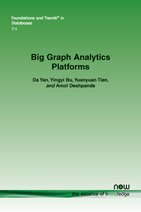Big Graph Analytics Platforms
By Da Yan, The University of Alabama at Birmingham, USA, yanda@uab.edu | Yingyi Bu, Couchbase, Inc., USA, yingyi@couchbase.com | Yuanyuan Tian, IBM Almaden Research Center, San Jose, USA, ytian@us.ibm.com | Amol Deshpande, University of Maryland, USA, amol@cs.umd.edu
Abstract
Due to the growing need to process large graph and network datasets created by modern applications, recent years have witnessed a surging interest in developing big graph platforms. Tens of such big graph systems have already been developed, but there lacks a systematic categorization and comparison of these systems. This article provides a timely and comprehensive survey of existing big graph systems, and summarizes their key ideas and technical contributions from various aspects. In addition to the popular vertex-centric systems which espouse a think-like-a-vertex paradigm for developing parallel graph applications, this survey also covers other programming and computation models, contrasts those against each other, and provides a vision for the future research on big graph analytics platforms. This survey aims to help readers get a systematic picture of the landscape of recent big graph systems, focusing not just on the systems themselves, but also on the key innovations and design philosophies underlying them.
Big Graph Analytics Platforms
The growing need to deal with massive graphs in real-life applications has led to a surge in the development of big graph analytics platforms. Tens of such big graph systems have already been developed, and more are expected to emerge in the near future. Although several experimental studies have been conducted in recent years that compare the performance of several big graph systems, Big Graph Analytics Platforms is the first text to provide a comprehensive survey that clearly summarizes the key features and techniques developed in existing systems. It aims to help readers get a systematic picture of the landscape of recent big graph systems, focusing not just on the systems themselves, but also on the key innovations and design philosophies underlying them. In addition to the popular vertex-centric systems which espouse a think-like-a-vertex paradigm for developing parallel graph applications, Big Graph Analytics Platforms also covers other programming and computation models, contrasts those against each other, and provides a vision for future research in the field.
Big Graph Analytics Platforms provides a timely and comprehensive survey of existing big graph systems, and summarizes their key ideas and technical contributions from various aspects. It is an ideal reference for researchers and practitioners already working, or about to embark on work in this growing area.
